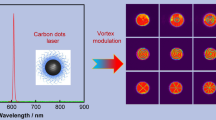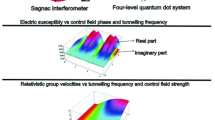Abstract
A vortex beam of light is used to enhance and control the lateral and rotary light drag effects in three-level graphene quantum dots. In this study, by using a vortex beam, two practical parameters are introduced to control the optical properties of the system and consequently enhance both the lateral and rotary light drag effects. These parameters are the orbital angular momentum and the azimuthal phase of the applied controlling vortex beam. By increasing the orbital angular momentum of the vortex beam, the absorption of the probe field decreases, while the lateral and rotary light drag effects increase. Furthermore, we found that the azimuthal phase of the vortex beam has a substantial impact on the optical properties of the probe field. Thus, it can be utilized as an efficient parameter for enhancing and controlling light drag effects.
Graphical abstract

Lateral light drag as a function of the medium transverse velocity. As demonstrated, increasing the amount of topological charge (l) and consequently the orbital angular momentum results in enhanced lateral light drag







Similar content being viewed by others
Data Availability Statement
This manuscript has no associated data or the data will not be deposited. The authors declare that the data supporting the findings of this study are available within the paper.
References
J. Stachel, A. Kox, and J. Eisenstaedt, The Universe of General Relativity, 2005
A. Fresnel, Lettre d’Augustin Fresnel à François Arago sur l’influence du mouvement terrestre dans quelques phénomènes d’optique, in Annales de chimie et de physique, 1818, pp. 57–66
L. Landau, E. Lifshitz, Continuous medium electrodynamics (Nauka, Moscow, 1982)
M. Fizeau, Sur les hypothèses relatives à l’éther lumineux, et sur une expérience qui parait démontrer que le mouvement des corps change la vitesse avec laquelle la lumière se propage dans leur intérieur. SPIE milestone series 28, 445–449 (1991)
A.A. Michelson, E.W. Morley, ART. XXXVI.--Influence of Motion of the Medium on the Velocity of Light. Am J Sci (1880-1910) 31, 377 (1886)
W. Macek, J. Schneider, R. Salamon, Measurement of Fresnel drag with the ring laser. J. Appl. Phys. 35, 2556–2557 (1964)
G. Sanders, S. Ezekiel, Measurement of Fresnel drag in moving media using a ring-resonator technique. JOSA B 5, 674–678 (1988)
H.A. Lorentz, Electromagnetic phenomena in a system moving with any velocity smaller than that of light, in Collected Papers. (Springer, Berlin, 1937), pp.172–197
P. Zeeman, "Fresnel’s coefficient for light of different colours (First part)," In Proceedings of Academy Science Amsterdam, 1914, pp. 445–451
P. Zeeman, Fresnel’s coefficient for light of different colours (Second part). Proc. Kon. Acad. Van Weten 18, 398–408 (1915)
P. Zeeman, The propagation of light in moving transparent solid substances. I. Apparatus for the observation of the fizeau-effect in solid substances, in KNAW, Proceedings, 1919, pp. 1919–1920
A. Snethlage, P. Zeeman, The propagation of light in moving, transparent, solid substances. II. Measurements on the Fizeau-effect in quartz. Proceed. Royal Netherlands Acade. Arts Sci. (KNAW) 22, 512–522 (1920)
A. Snethlage, P. Zeeman, The propagation of light in moving, transparent, solid substances. III. Measurements on the Fizeau-effect in flint glass. Koninklijke Nederlandse Akademie van Wetenschappen Proceedings Series B Physical Sciences 23, 1402–1411 (1921)
R. V. Jones, "‘Aether drag’in a transversely moving medium," Proceedings of the Royal Society of London. A. Mathematical and Physical Sciences, vol. 345, pp. 351–364, 1975.
R. V. Jones, "Rotary ‘aether drag’," Proceedings of the Royal Society of London. A. Mathematical and Physical Sciences, vol. 349, pp. 423–439, 1976.
U. Leonhardt, P. Piwnicki, Relativistic effects of light in moving media with extremely low group velocity. Phys. Rev. Lett. 84, 822 (2000)
H. Bilger, A. Zavodny, Fresnel drag in a ring laser: measurement of the dispersive term. Phys. Rev. A 5, 591 (1972)
M. Arif, H. Kaiser, S. Werner, A. Cimmino, W. Hamilton, A. Klein et al., Null Fizeau effect for thermal neutrons in moving matter. Phys. Rev. A 31, 1203 (1985)
A. Klein, G. Opat, A. Cimmino, A. Zeilinger, W. Treimer, R. Gähler, Neutron propagation in moving matter: the Fizeau experiment with massive particles. Phys. Rev. Lett. 46, 1551 (1981)
A.A. Svidzinsky, F. Li, X. Zhang, Generation of coherent light by a moving medium. Phys. Rev. Lett. 118, 123902 (2017)
D. Strekalov, A.B. Matsko, N. Yu, L. Maleki, Observation of light dragging in a rubidium vapor cell. Phys. Rev. Lett. 93, 023601 (2004)
A. Safari, I. De Leon, M. Mirhosseini, O.S. Magaña-Loaiza, R.W. Boyd, Light-drag enhancement by a highly dispersive rubidium vapor. Phys. Rev. Lett. 116, 013601 (2016)
A. Iqbal, N. Khan, B.A. Bacha, A.U. Rahman, A. Ahmad, Photon drag enhancement by a slow-light moving medium via electromagnetically-induced transparency amplification. Phys. Lett. A 381, 3134–3140 (2017)
A.H. Gharamaleki, A. Kevin, M.A. Tavakoli-Ghazi-Jahani, Light drag via electron tunneling and incoherent pumping in semiconductor three-level InAs/GaAs double quantum dot molecules. Eur. Phys. J. D 73, 1–7 (2019)
A.H. Gharamaleki, A. Kevin, Lateral and rotary light-drag enhancement in a vee+ ladder configuration comprising a Rydberg state. Phys. Scr. 96, 125524 (2021)
Y. Dong, L. Xiong, I. Phinney, Z. Sun, R. Jing, A. McLeod et al., Fizeau drag in graphene plasmonics. Nature 594, 513–516 (2021)
W. Zhao, S. Zhao, H. Li, S. Wang, S. Wang, M.I.B. Utama et al., Efficient Fizeau drag from Dirac electrons in monolayer graphene. Nature 594, 517–521 (2021)
A. Zahir, A.I. Bashir, N. Khan, S.S. Hayat, Quantum coherence-enhanced optical properties and drag of photons and SPPs in semiconducting quantum dots and resonantly-coupled dot–nanoparticle plasmonic interfaces. J. Phys. Chem. Solids 172, 111088 (2023)
A.I. Bashir, A. Zahir, N. Khan, S.S. Hayat, Controlling optical properties and drag of photon and surface plasmon polaritons in triple quantum dot molecules and dots-metal plasmonic interface via tunneling-assisted quantum coherence. Opt. Laser Technol. 149, 107915 (2022)
A.I. Bashir, A. Zahir, S.S. Hayat, Role of quantum-coherence dressed states on the Fresnel-Fizeau drag and optical properties of surface plasmon polaritons through asymmetric double quantum dot-metallic plasmonic interfaces. Surf. Interfaces 29, 101709 (2022)
A. Zahir, A.I. Bashir, S.S. Hayat, Quantum coherence-assisted optical properties and drag of SPPs on quantum dots and resonantly-coupled dots-metal plasmonic interfaces via interbands tunneling and Fano resonance. Opt. Mater. 126, 112227 (2022)
M. Bacon, S.J. Bradley, T. Nann, Graphene quantum dots. Part. Part. Syst. Charact. 31, 415–428 (2014)
P. Tian, L. Tang, K. Teng, S. Lau, Graphene quantum dots from chemistry to applications. Mater. Today Chem. 10, 221–258 (2018)
J. Shiri, A. Malakzadeh, Phase controllable terahertz switch in a Landau-quantized graphene nanostructure. Laser Phys. 27, 016201 (2016)
B. Trauzettel, D.V. Bulaev, D. Loss, G. Burkard, Spin qubits in graphene quantum dots. Nat. Phys. 3, 192–196 (2007)
A.L. Sanati, F. Faridbod, M.R. Ganjali, Synergic effect of graphene quantum dots and room temperature ionic liquid for the fabrication of highly sensitive voltammetric sensor for levodopa determination in the presence of serotonin. J. Mol. Liq. 241, 316–320 (2017)
F.A. Permatasari, A.H. Aimon, F. Iskandar, T. Ogi, K. Okuyama, Role of C-N configurations in the photoluminescence of graphene quantum dots synthesized by a hydrothermal route. Sci. Rep. 6, 1–8 (2016)
F. Xu, J. Zhu, S. Fan, Y. Qi, Control of slow light in three-and four-level graphene nanostructures. Mod. Phys. Lett. B 33, 1950226 (2019)
S. Liu, W.-X. Yang, Z. Zhu, R.-K. Lee, Effective terahertz signal detection via electromagnetically induced transparency in graphene. JOSA B 33, 279–285 (2016)
Z.-G. Chen, Z. Shi, W. Yang, X. Lu, Y. Lai, H. Yan et al., Observation of an intrinsic bandgap and Landau level renormalization in graphene/boron-nitride heterostructures. Nat. Commun. 5, 4461 (2014)
A.I. Bashir, Quantum coherence-assisted secure communication of internet of things information via Landau-quantized graphene. Opt. Quant. Electron. 55, 983 (2023)
A.M. Yao, M.J. Padgett, Orbital angular momentum: origins, behavior and applications. Adv. Opt. Photon. 3, 161–204 (2011)
L. Allen, M. Padgett, M. Babiker, IV The orbital angular momentum of light, in Progress in optics, vol. 39, (Elsevier, Amsterdam, 1999), pp.291–372
L. Allen, M.W. Beijersbergen, R. Spreeuw, J. Woerdman, Orbital angular momentum of light and the transformation of Laguerre-Gaussian laser modes. Phys. Rev. A 45, 8185 (1992)
N. Radwell, T.W. Clark, B. Piccirillo, S.M. Barnett, S. Franke-Arnold, Spatially dependent electromagnetically induced transparency. Phys. Rev. Lett. 114, 123603 (2015)
S. Sharma, T.N. Dey, Phase-induced transparency-mediated structured-beam generation in a closed-loop tripod configuration. Phys. Rev. A 96, 033811 (2017)
M. Babiker, W. Power, L. Allen, Light-induced torque on moving atoms. Phys. Rev. Lett. 73, 1239 (1994)
V. Lembessis, M. Babiker, Light-induced torque for the generation of persistent current flow in atomic gas Bose-Einstein condensates. Phys. Rev. A 82, 051402 (2010)
Z. Dutton, J. Ruostekoski, Transfer and storage of vortex states in light and matter waves. Phys. Rev. Lett. 93, 193602 (2004)
J. Ruseckas, G. Juzeliūnas, P. Öhberg, S.M. Barnett, Polarization rotation of slow light with orbital angular momentum in ultracold atomic gases. Phys. Rev. A 76, 053822 (2007)
D.-S. Ding, Z.-Y. Zhou, B.-S. Shi, X.-B. Zou, G.-C. Guo, Linear up-conversion of orbital angular momentum. Opt. Lett. 37, 3270–3272 (2012)
G. Walker, A. Arnold, S. Franke-Arnold, Trans-spectral orbital angular momentum transfer via four-wave mixing in Rb vapor. Phys. Rev. Lett. 108, 243601 (2012)
A. Rahmatullah, Q. Ziauddin, Spatially structured transparency and transfer of optical vortices via four-wave mixing in a quantum-dot nanostructure. Phys. Rev. A 101, 023821 (2020)
H.R. Hamedi, J. Ruseckas, E. Paspalakis, G. Juzeliūnas, Transfer of optical vortices in coherently prepared media. Phys. Rev. A 99, 033812 (2019)
S. Kevin, M. Sahrai, S.H. Asadpour, Controllable Hartman effect by vortex beam in a one dimensional photonic crystal doped by graphene quantum dots. Sci. Rep. 13, 2992 (2023)
M. Sahrai, M. Abbasabadi, All-optical switch based on doped graphene quantum dots in a defect layer of a one-dimensional photonic crystal. Appl. Opt. 57, 521–526 (2018)
E. Schöll, L. Schweickert, L. Hanschke, K.D. Zeuner, F. Sbresny, T. Lettner et al., Crux of using the cascaded emission of a three-level quantum ladder system to generate indistinguishable photons. Phys. Rev. Lett. 125, 233605 (2020)
E. Moreau, I. Robert, L. Manin, V. Thierry-Mieg, J. Gérard, I. Abram, Quantum cascade of photons in semiconductor quantum dots. Phys. Rev. Lett. 87, 183601 (2001)
S. Schmaus, V. Koerting, J. Paaske, T. Jespersen, J. Nygård, P. Wölfle, Nonequilibrium cotunneling through a three-level quantum dot. Phys. Rev. B 79, 045105 (2009)
A.I. Bashir, S.U. Batool, A. Arif, A. Shazad, Dispersion-dependent superluminal propagation and photon drag in GaAs/AlGaAs quantum dot molecule. Phys. Scr. 98, 115116 (2023)
M.O. Scully, M.S. Zubairy, Quantum optics (Cambridge University Press, Cambridge, 1997)
Author information
Authors and Affiliations
Contributions
AHG initiated the project and supervised it. SK performed the numerical simulations and analytic calculations. All authors discussed the results and contributed to the final manuscript.
Corresponding author
Rights and permissions
Springer Nature or its licensor (e.g. a society or other partner) holds exclusive rights to this article under a publishing agreement with the author(s) or other rightsholder(s); author self-archiving of the accepted manuscript version of this article is solely governed by the terms of such publishing agreement and applicable law.
About this article
Cite this article
Kevin, S., Gharamaleki, A.H. Theoretical investigation of lateral and rotary light drag by a vortex beam in graphene quantum dots. Eur. Phys. J. D 78, 47 (2024). https://doi.org/10.1140/epjd/s10053-024-00836-4
Received:
Accepted:
Published:
DOI: https://doi.org/10.1140/epjd/s10053-024-00836-4




